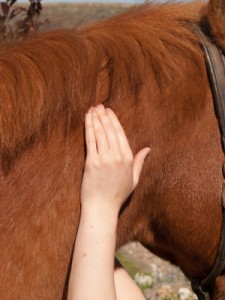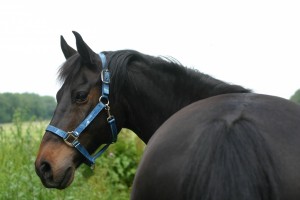All of us are born with the sense of touch and a set of feeling hands. 
You don’t have to know the names and function of every muscle, bone and joint in your horse’s body to garner benefit from, well, quite simply, feeling your horse.
Some of my fondest memories during my equine massage therapy studies at the D’Al School (at D’Arcy Lane in London, Ontario) are the times I spent out at the barn alone with my horse after school, just gently palpating and feeling and sensing. He gave me some pretty priceless looks and it was a unique experience to interact and spend time with him in this way.
Familiarizing yourself with how your horse’s body feels is a great way to become more familiar with their anatomy and can help you detect changes and signs of strain or discomfort early on. It’s also a neat exercise in developing your sensitivity and awareness, and can provide some quality bonding time as your horse begins to show you where and how he or she likes to be touched.
The four T’s
As you touch your horse’s body, feel for differences in the “four T’s”. Some areas of your horse’s body will naturally feel more tight, firm or warm to the touch. When accompanied by pain or discomfort, or if representing a change from your horse’s “normal”, these may be early warning signs of an issue.
Temperature: Are there areas that feel particularly warm in comparison to the surrounding tissues? Does one hoof tend to feel warmer than the others? Do the flexor tendons feel warmer in one place or on one foreleg more than the other?
Tension: Are there areas that feel tighter than others? Does this differ from one side of the body to the other?
Tenderness: Are there areas where your touch evokes a protective reaction from your horse (flinching, moving away, tail swishing, ears back, increased tension)? How does this compare to the same area on the other side?
Texture: Are there areas with a boggy feel to them? Swelling? How organized do the tissue fibers feel? Can you feel scar tissue under the skin?
Some guidelines for your practice
Starting at the top of your horse’s neck, slowly work your way over their entire body, from front to back and down to their hooves. Over muscles you can add an ever so slight squeezing pressure. While over the joints of the legs simply place a hand on either side and feel for heat or tenderness.
Use a gentle touch, keeping your hands relaxed, with a slight bend in the knuckles. You want to allow your palms and finger pads to do the feeling (where we have the most sensory receptors). Excess tension in your hands will also limit your sensitivity.
Avoid putting pressure on areas that feel hard — if something doesn’t yield to your touch it is likely bone. The cervical vertebrae in the middle of the neck, for example, are often mistaken for ominous bumps or “knots” by those unfamiliar with the anatomy.
Remember to use caution when touching areas where your horse might be sensitive (like their girth area) or where they might not be used to being touched (like the inside of their thigh). If there are areas where your horse doesn’t accept your touch, gradually work up to it over a number of sessions.
As you proceed, try to keep an open mind so you can be attuned to what you are feeling in your hands, rather than what your brain is thinking. The more you practice the greater your sensitivity will improve and the more adept you will become at deciphering what “normal” is for your horse.
Happy feeling!



